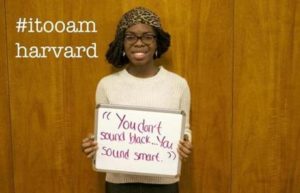It was historian and Harvard Alumni W.E.B. DuBois, who suggested in his 1903 lamentation, “The Souls of Black Folk,” that the question, “How does it feel to be a problem,” was ever existent between him and the other world. This question is usually masked by seemingly less threatening, but equally as isolating questions in which the former is still understood, as Blacks are socially conditioned to read between racial lines.
More than a century after “Souls,” students of color at DuBois’ alma mater are still being asked “How does it feel to be a problem,” their answer is “I, Too, Am Harvard,” a play-turned-social justice and language equality campaign that has gone viral. The student-led group of the same name colorfully attacks every notion that their racial and ethnic backgrounds make them inferior to their peers.
The group of Harvard students is shown on video sharing short testimonials and on Tumblr, a photo sharing social network, holding visuals that reflect the discrimination experienced through conversations with peers of other races.
“I, Too, Am Harvard” has sparked conversation domestically and abroad, inspiring similar campaigns at other universities. Students at England’s Oxford University have begun an “I, Too, Am Oxford” campaign.
The students at both institutions are making it clear that their differences are cause for celebration, not alienation, and that they deserve to sit in the same class rooms, walk the same halls and enjoy the same opportunities, without questions suggesting otherwise.



